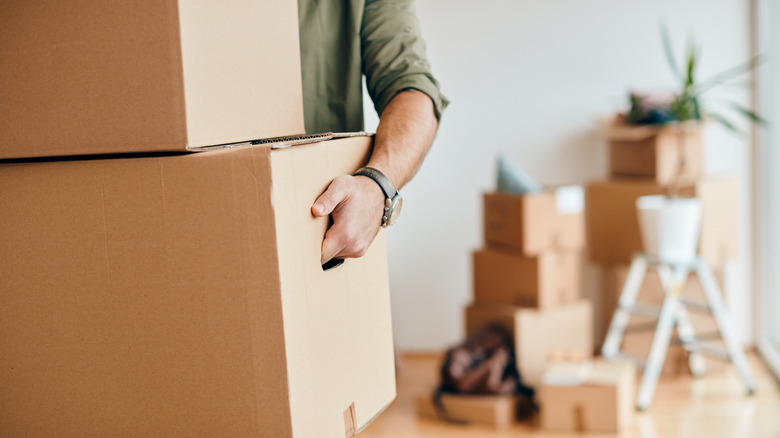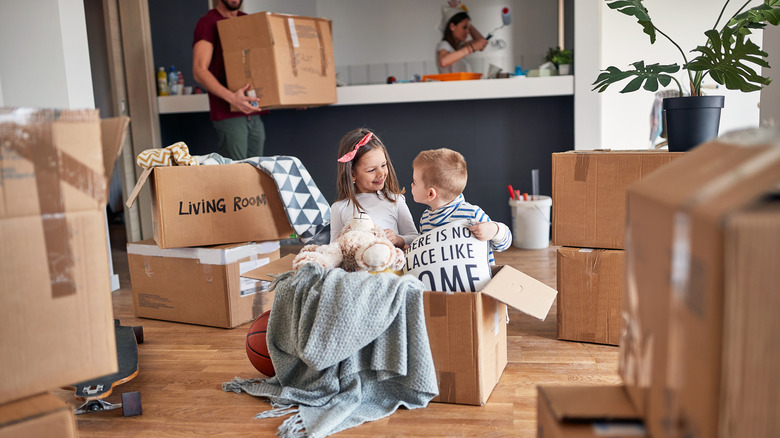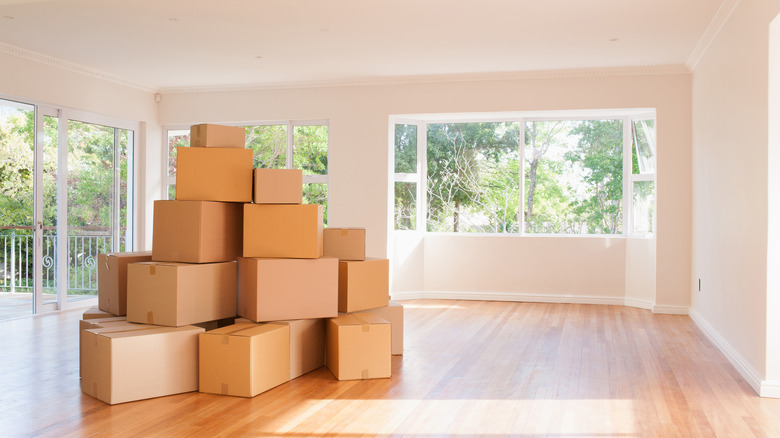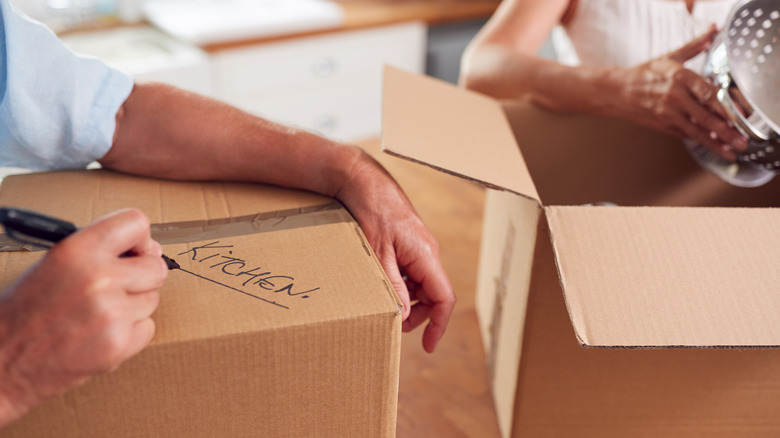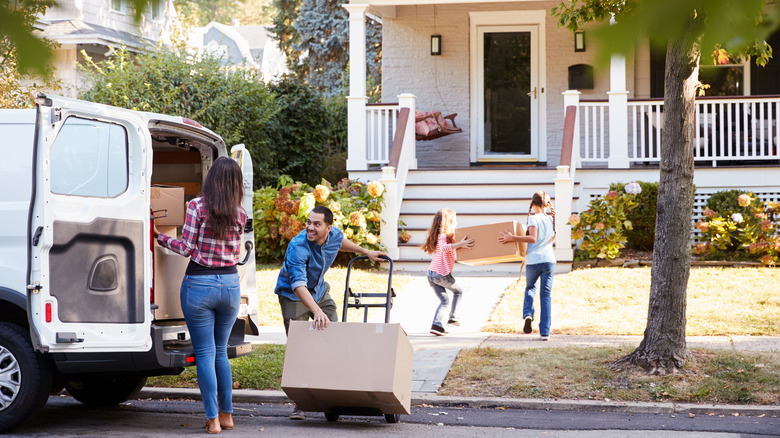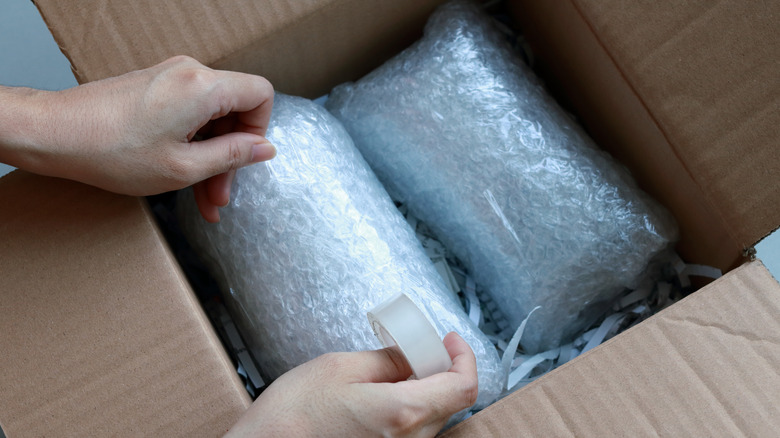Myths You Should Stop Believing About Moving
Moving makes a few folks shiver or smile at the thought, depending on their experience. Having to bubble-wrap delicate décors, donate items you'll never use, and pack up everything else in cardboard boxes can be stressful. According to a survey, most respondents claim that moving is more stressful than getting divorced, via StudyFinds. In addition, moving out ranked having children, getting married, and going through a breakup. According to Study Finds, most respondents who stated moving was nerve-racking also claimed they'd never move again. Unpacking and fitting furniture through tight doorways is why folks dread moving.
On the other hand, moving doesn't have to be taxing. While there are various myths, you might've heard from different movers regarding the best time to move, how you should pack, or things you shouldn't pack until you move, the process could be fun through proper planning. Real estate blogger, The Cliffs suggests making a plan that involves timeframes for everything that needs to get done, such as hiring a moving company, getting a rental truck, packing, etc. Having a set plan allows you to be more organized and sort through items you don't need making room to decorate your new space with different embellishments. We know it can be tedious to move, and folks have various opinions on the right way to move, but among the many tips, there are a few myths you should stop believing.
You only have one day to move everything
The pressure of moving in one day can cause a lot of stress, but you don't have to limit yourself to only one day. Folks who want to move all their belongings into their new space in a day most likely have numerous extra hands helping out. A few days is enough to transfer all the packed boxes, furniture, and miscellaneous items into a new place. Life Storage Blog claims that there are different time frames for moving, whether you're buying a house or renting an apartment.
For example, when you buy a home, the closing date will give you an idea of when you're allowed to move in so that you can plan everything that needs to get done. Likewise, for an apartment, depending on when the old lease ends and the new one begins. Although if your end date and move-in date aren't close in time, it can delay the process. You might have to move out from your current place before moving into your new one, which means renting out a storage unit for a little while. When you do move in, place packed boxes in rooms the items will occupy so you don't have to move boxes from room to room. In addition, take a few days to unpack a couple of rooms at a time, so you don't stress over having to unpack everything at once.
Taking advantage of free boxes
The one thing you don't want to happen is picking up a box and having everything inside fall from the bottom of it. Or, if you snag a few from the grocery store, you could end up with boxes full of insects. It'll be challenging to get rid of the bugs once they're inside the house or have made their way into your clothing.
While it's nice not to have to pay for boxes since you'll only use them a couple of times, it's better to pay for them in excellent condition. Moving has an estimated price range from slight to large boxes, costing anywhere between $1 to $12 per box. PODS blog states buying new boxes is better than reused ones because they're sturdier with sharp corners, so stacking them will be easier and won't topple over or get crushed underneath all the boxes. Plus, new boxes won't have previous labels, so you won't get confused about what's inside and open it to figure it out.
You don't have to label boxes
The one thing that could make unpacking stressful is not labeling any of the boxes. On the other hand, if you do label boxes but use a lightly colored marker that can make it hard to read what's been written, use a darker marker. According to Rabbit Movers, there are different ways to label moving boxes efficiently, and they'll be helpful to not only you but anyone you've asked to help. A skillful way to mark the boxes is by listing the items inside or what category they pertain to (via Rabbit Movers). For example, if you have multiple boxes with living room décor, you can number and label every box you will unpack in the living room.
It's important to note that labeling boxes that have delicate items are crucial to prevent anything from breaking. For example, writing "fragile," "high priority," or "this side up" will help movers be cautious when they carry the boxes around the house. In addition, labeling every side of the box will make it easier for everyone to know where to place it without having to turn it over multiple times.
Friday is the ideal day to move
In retrospect, moving into a new place on a Friday sounds like a good idea, but it can be the worst time. Even though it's at the end of the week and you have weekends off where you can unpack with the help of friends and family, it can be expensive to move. MovingTips states it's better to move during the week. Moving companies spike their prices on the weekends because that's the peak time, especially at the beginning or end of the month. Also, since it's their busiest moment, fewer workers might be available so you could get help from less experienced movers.
When you move during the week, you can save money and receive the best help. Plus, most stores are open on weekdays, so if you're having issues with utilities, you can call someone to check it out (via MovingTips). Throughout the week, the streets are emptier since folks have to work, so your neighbors won't be around to peak at who's moving in next door. As a result, there won't be any disruptions, and you'll have more space and time for the rental truck to stay parked in the street or driveway.
Expect something to break along the way
Expecting something to break when you unpack shows the packing wasn't done well in the first place. Even though transporting boxes can be stressful, there are ways to prevent every item from getting damaged. According to Cassidy's Moving & Storage, prepping is imperative for packing. Choosing the right-sized boxes can help fit everything perfectly, primarily if they're categorized. Prevent leaving open gaps in the box while ensuring they don't get crammed with things. Leaving space allows the items inside to move around and bang against each other, per Cassidy's Moving and Storage. Overstuffing the boxes can make them hard to stack when they have bent or lumpy parts.
Bubble wrap for delicate décors can keep them in good condition. When layering them with moving blankets, it'll offer extra protection. Taping each side with durable packing tape will prevent flaps from opening. Overall, ensuring everything is wrapped securely inside the boxes will establish smooth transport.
